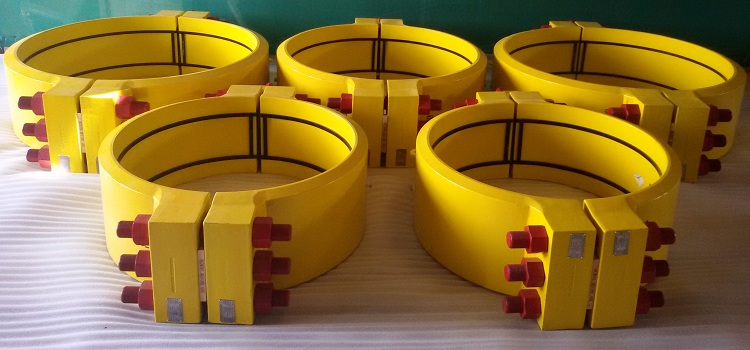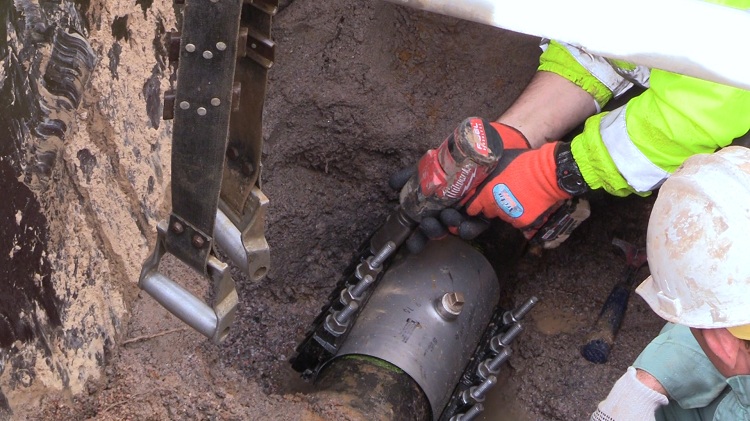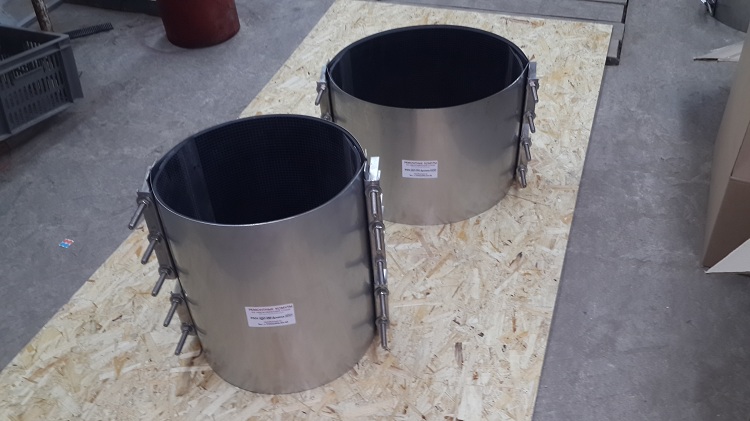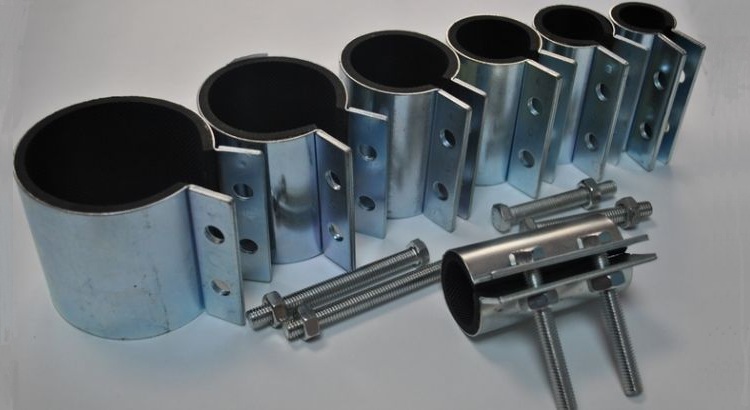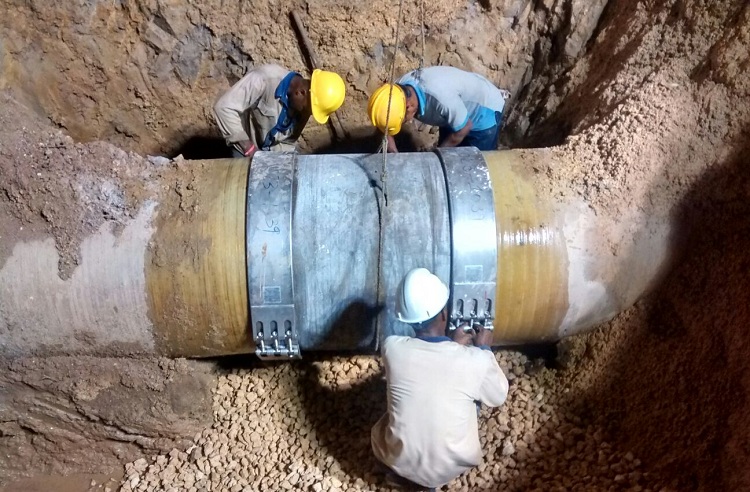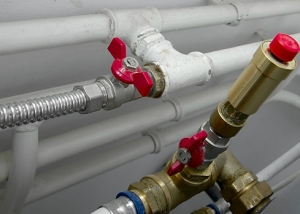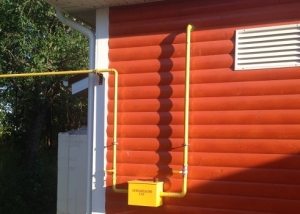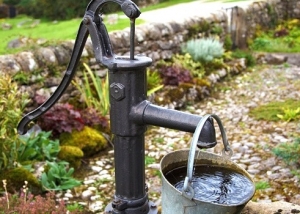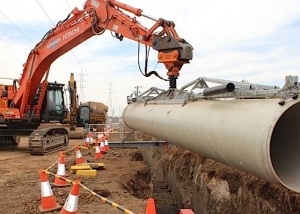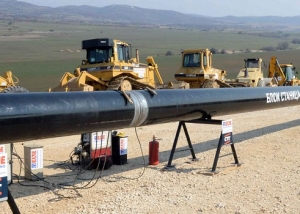Repair pipe clamp is used as an ambulance for various damages in pipelines. Thanks to repair clamps, it is also possible to replace a separate section of the pipeline without shutting down the entire water supply system. And although the imposition of such a detail on the pipe during its breakthrough is considered a temporary measure, the performance of the system repaired in this way can remain at a high level for quite a long time. The range of these products is quite wide, so choosing the right item for each specific case is not difficult.
Content
Use of clamps
The use of a repair pipe clamp allows you to cope with minor injuries, block a bursting area or close a leak formed during corrosion. This repair device allows you to quickly and easily cope with the problem.
They are used in various sections of the pipeline - horizontal and vertical. On bends, tees and crosses, this device is ineffective and, in such cases, its use is strictly forbidden. The material of repaired pipes can be anything - from ductile copper to more brittle cast iron. In this sense, there are no restrictions. For pipelines that are made of various polymers, special devices exist. They can be easily purchased at any hardware store.
Note! Sometimes clamps are used as a grounding element of a pipeline structure. This is a very useful quality. The product simultaneously performs the function of fixing and grounding the pipeline structure.
In addition, there is a repair product made of asbestos cement. But this type of clamp is used quite rarely because of its specific qualities.
Varieties of defects that repair clamps can handle
Such products are able to cope with a variety of breakdowns in the pipes. Namely:
- pipe breakthrough;
- pipeline fistula. In this case, use a clamp that is equipped with an elastic gasket. The gasket is pressed firmly into the fistula and closes it;
- cracks in the pipeline. In this case, repair devices can eliminate leakage from both small and large splits on the pipe wall;
- pipe fracture. The clamp not only copes with this problem, but can also act as a mount to a fixed support (wall);
- welding defects;
- needle holes;
- mechanical damage (from shock).
Key Features
The clamps have a number of important characteristics that determine the features of operation:
- the working pressure of this connecting element, depending on the model, ranges from 6 to 10 atmospheres;
- the maximum temperature at which it is allowed to use the device is up to +120 degrees;
- the operating mode, as a rule, ranges from –20 to +60 degrees;
- the diameter of the device can be from 15 to 1200 mm;
- fasteners for clamps are made of stainless steel or galvanized steel;
- the cuff of the device is made of special rubber - corrugated.
- the body of the product consists of a tape, which is made of stainless steel and has a different thickness, but basically this figure is 1-2 mm. In some cases, cast iron tapes are used.
Technical data of the products are presented in table No. 1.
Table 1
| Diameter (mm) | N (mm) | L (mm) | D (mm) | Dt (mm) |
| 400 | 960 | 310 | 580 | 482 |
| 350 | 930 | 290 | 520 | 430 |
| 300 | 740 | 270 | 455 | 370 |
| 250 | 664 | 250 | 400 | 320 |
| 200 | 562 | 230 | 340 | 268 |
| 150 | 448 | 210 | 285 | 212 |
| 125 | 376 | 200 | 250 | 188 |
| 100 | 334 | 190 | 220 | 158 |
| 80 | 297 | 180 | 200 | 138 |
| 50 | 241 | 150 | 165 | 102 |
| 40 | 241 | 140 | 150 | 83 |
Advantages and disadvantages of the repair clamp
The advantages include the following properties of the device:
- Multifunctionality. Using such connecting elements, pipes from various materials are repaired: steel, cast iron, plastic and reinforced concrete.
- Cheapness. Installing a clamp is an inexpensive and reliable way to deal with pipe breakage.
- Easy installation. The installation of this device does not require any special skills and, using the instructions, anyone can carry it out.
- Heat resistance. The material of the product is able to tolerate high temperatures.
- Durability. This factor depends on the manufacturer and the material of the product. If the part is made with high quality and has all the necessary characteristics, then it will last a long time.
Disadvantages:
- The clamp can be used to repair damage only to flat pipe sections.
- The device has certain limitations. The width of the damaged part of the pipe should not exceed 340 mm.
Important! The damaged part of the pipeline can also be repaired with the help of an adhesive bandage. In this case, fiberglass impregnated with a special glue is used.
Operating conditions
The clamps have certain characteristics and the conditions for their use must correspond to them.
- It is strictly forbidden to use a device whose length is less than the diameter of the pipe being repaired.
- If the pipe diameter is 350 mm, then in this case it is recommended to use models whose length is 150 mm greater than the size of the damaged area.
- For pipelines with a pipe diameter of more than 350 mm, devices are used whose length has a margin of 200 mm.
- In the implementation plastic pipe repair It is worth choosing a product with a length of 1.5 times the damaged area.
- When connecting two pipes, it is worth remembering that the distance between them should not be higher than 10 mm. Pipe deflection angle is allowed within 2-3 degrees.
- If the damage area of the pipe exceeds 60%, a complete replacement of the problem area is recommended.
The main varieties of repair clamps
According to the material, repair clamps are divided into:
- plastic;
- metal.
Plastic products can be used to secure the pipe, which is in a movable state. They can be whole or double. Plastic products are practical and very durable devices, which allows you to quickly and reliably cope with pipe repair. The main positive quality of polymer devices is their resistance to the harmful effects of corrosion. The disadvantage of this type of clamps is their weak resistance to mechanical stress.
Important! The use of a clamp is considered a temporary method to eliminate the problem. In any case, it is better to completely replace the damaged section of the pipeline.
Metal products are able to make a reliable and durable connection. Unlike plastic counterparts, they are more resistant to mechanical damage.Steel products, which are usually made of galvanized or alloy steel, are very popular. Such clamps have a rubber layer on the inside. Another difference from plastic devices is that metal clamps are capable of absorbing vibrations in the system.
The main varieties of clamps by design features:
Unilateral. A common type of clamp, made in the form of the letter U with perforation in the upper part. This type, as a rule, is used to repair pipes of small diameter (for example, DN 50).
Bilateral. The composition of this product includes two elements that are joined together by special screws. The choice of such a device is made taking into account the diameter of the pipe and the nature of the damage.
Compound. Devices of this plan are used to repair pipes with a large diameter. A multi-part clamp consists of three or more elements. The installation of this device is made on several threaded pairs.
Fixing. According to its characteristics, it does not practically differ from a single-component and two-component type. The difference between this type of product is that it has a special fastener, which includes a self-tapping screw. Due to this, the clamp provides reliable attachment of the pipe to the wall.
The main stages of installation
After choosing and buying the desired clamp, its installation is carried out in the following sequence:
- Before starting the installation, it is worth unscrewing the fixing element of the clamp. The ends of the product are bred to the desired width so that it is easy to place on the pipe.
- Next, you need to be careful and make sure that the rubber layer is located directly above the damaged area and completely covers it. It is advisable that the edges of the gasket extend beyond the damaged area by 3 cm.
- Then the product is fixed. Fasteners are inserted into the holes that are located at the edges. The resulting structure is tightened with nuts. If it continues to flow from the pipe, it is worth tightening the clamp even more until a reliable clogging of the damaged area occurs.
When choosing a pipe clamp to repair a pipe, you first need to pay attention to the nature of the damage. These products have a wide enough range to select the necessary device for pipe repair any purpose. When installing the clamp with your own hands, you must strictly follow the necessary rules and then this product will help to effectively solve the problem.
